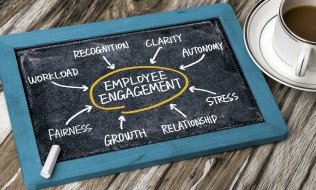
To celebrate International World Happiness Day on March 20, Klick Health hosted a number of activities for employees at its Toronto office, including canine visitors from the humane society, a catered lunch and bouncy castles.
“Basically, a heightened bit of happiness. We want people to get involved and be engaged with the company,” said David Holmes, the company’s director of employee engagement, during the Globe and Mail‘s 2018 Solving Workplace Challenges event in Toronto on Tuesday.
Holmes joined a panel of former winners of Morneau Shepell Ltd. and the Globe‘s annual employee-recommended workplace awards. Klick Health believes in empowering employees to do what they want, he said. “It’s as simple as that, and it’s quite successful in terms of maintaining employee happiness.”
Read: Nestle, Pfizer, TD Bank among top employee-recommended workplaces
For Nestlé Canada Inc., employee empowerment is about challenging people to make good decisions and allowing them to take risks, said Carl Jafrabad, director of total rewards and human resources business partner at the company.
“It’s not going to work every time; we’ve all made errors and that’s OK, that’s part of the learning culture, part of growing,” he said. “It’s part of demonstrating that we accept the good and the bad together, and we really try to empower people to push forward and take the company to the next step, like they run the company or own the company, really push it forward and go for it.”
Payroll accounting company Deluxe Payroll was also another award winner in the category of small, publicly traded business, which means its has limited resources because of both its size and the fact it has to present its budget annually for approval, said Nicolas Drapeau, the company’s manager of onboarding.
“There are a lot of nice perks that other workplaces may offer that we just can’t right now,” he said, noting the company looks at what it can do for employees that aligns with its business. ”And we promote it for the fact that it makes business sense.”
Read: Canada bucks trend towards higher employee engagement in 2017
Sklar Wilton & Associates Ltd. also had limited resources to work with, according to Sarah Liverance, a partner at the marketing consultancy. “We had to be thoughtful about what we chose to invest in.”
The company wanted to maintain employees’ work-life balance but also provide them with learning and development opportunities, she said. “So we took the intersection of those two things and we said, ‘Wouldn’t it be great to equip our team with a tool kit of resources they can draw upon to help them get through life, to be better mothers, husbands, sons, daughters, parents, all of that.’
“So we came up with this notion of a whole-person development program. It’s really been a combination of internally developed content as well as externally sourced. We’ve offered everything from personal goal setting, great habit formation, financial planning, all the way through to the physical aspects like nutrition, exercise, energy management, sleep, all the way to the most spiritual and mental sorts of content,” said Liverance.
“We’re continuing to pursue this and four years in. It’s continuing to yield great results. People talk about it as life-changing, and it’s been a real cornerstone of our engagement program.”
Read: Sing while you work: The well-being benefits of a workplace choir
Ultimately, the panel agreed that employee engagement comes down to listening to what staff want.
“For us, as times have changed and as culture has continued to evolve, we made a conscious decision to stop and listen . . . to what people have to say,” said Jafrabad. ”It’s not always expensive; sometimes it’s the more simple things: bringing in flexibility, allowing them to do those things that show that trust, that empowerment. And that really allows people to feel like they’re giving something . . . just by opening up those channels and saying, ‘We’re listening,’ and, ‘We’re going to offer those things.'”
Liverance noted Sklar Wilton & Associates has gone through a similar journey, using its employee engagement survey as a qualitative learning tool. “It was the listening and then the customizing,” she said.
Read: Younger employees prioritize ‘purpose’ of work before pay, benefits: report
